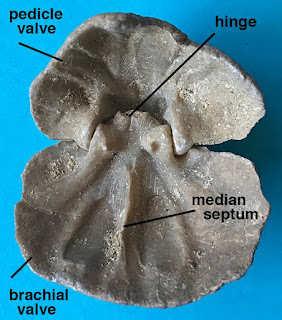Some Paleozoic gastropods have a selenizone (for example, please use the search engine for this blog and see my previous post on bellerophont gastropods). During the Paleozoic and Mesozoic, selenizone-bearing gastropods lived in shallow-marine waters. Unfortunately for them, they became easy prey for large fish and reptiles. To gain protection from predators, near or after the end of the Cretaceous, selenizone-bearing gastropods either largely retreated to deeper waters or lived in rocky shoreline environments where most predators were not likely to invade.
Today, selenizone-bearing gastropods are represented by three families: Pleurotomariids, Haliotidae, and Sissurellidae.
Pleurotomariids are restricted mainly to deep waters on the continental shelf, typically in waters of 100 m depth or greater. They are uncommon and hard to catch, and fishermen have to use nets or submarines. Thus, they are considered to be rare and, therefore, worth a lot of money. The discovery of the first living one in 1856 caused a lot of scientific excitement.
Mikadotrochus hirasei Pilsbry, 1903 is a prime example of a living pleurotomariid, and its common name is the "emperor slit shell." It is found in the Western Pacific, especially off the coast of Japan, China, and Taiwan. On the specimen pictured above (side view), you can readily see the long slit (selenizone), located at and in the proximity of the end of the last whorl of this top-shelled shell. This particular specimen is 3.25 inches tall and 4.5 inches in diameter. Its shell interior has a characteristic "mother-of-pearl" luster.
The mother-of-pearl luster is also discernible in the ventral view of the same specimen, where outermost layer of shell are not present or are not thick.
Haliotids have a flat shell, thereby allowing the animal to attach its large muscular "foot" to various hard substrates (rock, pilings, other shells, etc.). Sea water is drawn in under the edges of the shell, passes over the gills, and exits via the natural holes.
Haliotis rubra Leach, 1814 ("abalone"). This specimen (2.5 inches diameter), which is from the south coast of New South Wales, Australia, shows about 10 open holes and about two dozen or so "closed" holes. The latter are present all the way to the top of the spiral tip of the shell. They were formerly open, when the gastropod was young, but as the gastropod grew, it filled in these early holes to keep out marauding predators.
Haliotis rufescens Swainson, 1822 ("red abalone"). This specimen (7 inches diameter) is from California. This species is the largest of all abalones, reaching over 11 inches in diameter. It ranges from Sunset Bay, Oregon to Turtle Bay, Baja California. It requires active surf and wave conditions, and it inhabits mainly intertidal rocky shores in certain areas, and it is most abundant in northern California. Abalones are vegetarians.
This image shows the interior of the same specimen. You can readily see the iridescent "mother-of-pearl" nacre layer, which is a well-known characteristic of genus Haliotis. Its shell is used in costume jewelry.
Scissurellids are minute gastropods having a spiral slit (selenizone). The geologic record of this family is Late Cretaceous (rare) to Recent.
This image of a modern scissurellid (a few millimeters in diameter) is from en.wikipedia.org.




















